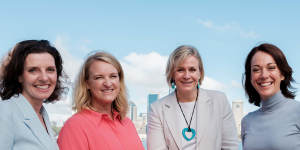The success of the so-called teal candidates means the Liberal Party no longer has any electorates overlooking Sydney Harbour. Independent triumphs in Wentworth,North Sydney and Mackellar,along with Zali Steggall’s re-election in Warringah,means teal-held territory now stretches from Clovelly to Palm Beach and from Manly to Hunters Hill.

Teal independents Allegra Spender (Wentworth),Kylea Tink (North Sydney),Zali Steggall (Warringah) and Sophie Scamps (Mackellar).Oscar Colman
But the independent sweep was not limited to the affluent suburbs to Sydney’s north and east.
Former state Liberal candidate turned independent was victorious in the south-western Sydney electorate of Fowler,which until the weekend ranked among Labor’s safest seats.
Le’s win was a of former NSW premier Kristian Keneally,who had been parachuted into the electorate by the ALP following the retirement of long-term Labor MP Chris Hayes. Labor’s primary vote in Fowler collapsed from 55 per cent to 36 per cent (with 75 per cent of the votes counted).
The result in Fowler,an ethnically diverse,working-class electorate taking in the districts of Liverpool and Cabramatta,shows the major party machines install high-profile outsider candidates at their peril,even in ultra-safe seats.
The success of teal independents sends a comparable message – voters in heartland seats will be attracted to capable and articulate local independents deeply connected to their community. It is also significant that all the independents who won seats across Sydney on Saturday are accomplished women.
The willingness of voters across Sydney to opt for strong independent candidates is not surprising. The Australian Election,conducted following each federal election,showed partisan support for the two main political parties reached its lowest level on record in 2019.
A striking feature of Sydney’s newly drawn electoral map is the declining share of Liberal seats. Assuming the Liberals lose the electorate of Bennelong (where they trail Labor by 1600 votes with nearly 80 per cent of the count completed),the party will hold seven of the 26 seats within the Sydney basin,only two more than the total now in the hands of independents. This is a much lower Liberal presence than normal,even following past Coalition election defeats.
The Liberal losses to independents and Labor reduce the party’s representation at the federal level in Sydney to a few outer suburban clumps – the seats Bradfield,Berowra and Mitchell in the north,the electorates of Banks,Cook and Hughes in the south,plus the Penrith-based seat of Lindsay,the lone Liberal stronghold in the city’s west. (Labor is on track to pick up the inner urban seats of Reid and Bennelong,giving it 14 of the 26 seats in the Sydney basin – a net gain of one following Saturday’s election.)
The success of independents within Liberal and Labor political heartlands sends a powerful message to both parties with the NSW election only nine months away.
The loss of so many Liberal seats is an obvious headache for Premier Dominic Perrottet.,which meant candidates in several seats in the state were installed only days before the federal election was called,hampered the party’s performance. Perrottet has labelled this preselection process a “debacle” and demanded an overhaul. But the bitter divisions within the NSW Liberals could undermine his chances at the state election in March.
The federal results also expose challenges for NSW Labor. The ALP won only 33 per cent of the primary vote in NSW on Saturday (with 72 per cent of the vote counted). That’s on par with the 2019 state election result,when Labor fell way short of a majority.
But perhaps the starkest lesson to emerge from Saturday’s political earthquake is that voters want to be represented by capable locals in touch with the community’s concerns.
Herald editor Bevan Shields sends an exclusive newsletter to subscribers each week..